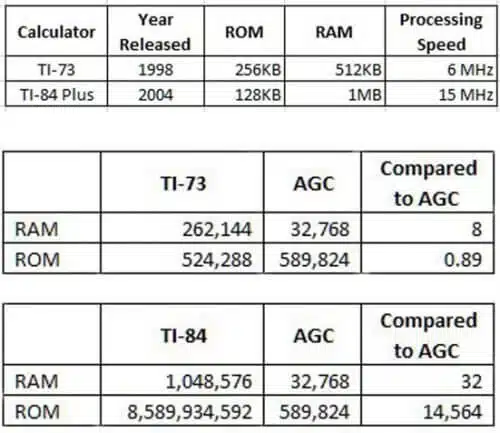It seems surprising. After all, when we talk about this historic event, we often say that we have more computing power in our pocket than the Apollo 11 computer. Is that true? And if so, how many times more powerful are our phones than the historical computer that landed humans on the moon?

Author: Graham Kendall, Professor of Computer Science, University of Nottingham, UK
Many people who are old enough to experience the first moon landing vividly remember watching Neil Armstrong say his famous quote "one small step for a man, one giant leap for mankind". Half a century later, the event is still one of the great achievements of the human race. Despite rapid technological advances since then, astronauts have not returned to the moon since 1972.
It seems surprising. After all, when we talk about this historic event, we often say that we have more computing power in our pocket than the Apollo 11 computer. Is that true? And if so, how many times more powerful are our phones than the historical computer that landed humans on the moon?
On board Apollo 11 there was one central computer (AGC - the Apollo guidance computer). It had 2048 words of memory, which could be used to store "temporary results" - data lost when the power went out. This type of memory is called RAM (Random Access Memory). Each word consists of 16 binary digits, series of zero or one. This means that the Apollo computer had 32,768 bits of RAM. It also had 72K of read-only memory (ROM) which equals 589,824 bits. This memory is programmed and cannot be changed once programming is complete.
One alphabetic character - say "a" or "b" - usually requires eight bits of storage. That is, the Apollo 11 computer will not even be able to store this article in RAM. Compare it to the mobile phone or MP3 player and you can appreciate that they can store much more - thousands of emails, videos, songs and photos.
Phone memory and processor
To put it into proportion, current phones usually have 4GB of RAM which is 34,359,738,368 bits. That's more than a million times (1,048,576 to be exact) more memory than the Apollo computer's RAM. The iPhone also has up to 512GB of ROM memory which is 4,398,046,511,104 bits, more than seven million times that of the Apollo guidance computer.
But memory is not the only thing that matters. The Apollo 11 computers had a processor - an electronic circuit that performs operations on external data sources - that ran at 0.043 MHz. The latest iPhone processor is rated at 2490 MHz. Apple doesn't publish the processing speed, but others have calculated it. This means that the iPhone in your pocket has more than 100,000 times the processing power of the computer that landed man on the moon 50 years ago.
The situation is even more complex when you consider that the iPhone also has additional built-in processing units responsible for certain tasks, such as the display.
What about a comparison to calculators (pocket computers)?
Of course, it's not wise to compare iPhone X to the computer that landed Apollo on the moon, but before they became apps on the phone, we used a lot of calculators (pocket computers). Texas Instruments was one of the most famous manufacturers of calculators. In 1998 they released the TI-73 calculator, and in 2004 they released the TI-84.
The tables below list the specifications of these two calculators:

If we compare the two calculators against the Apollo computer, we can note that the TI-73 has slightly less ROM, but eight times more RAM. By the time the TI-84 was released, the amount of RAM had increased 32 times that of the Apollo computer while the ROM was now 14,500 times more powerful.
Regarding processing speed, the TI-73 was 140 times faster than the Apollo computer and the TI-84 was almost 350 times faster.
The thought that a simple calculator, designed to help students pass their exams decades ago, was more powerful than the computer that landed man on the moon is pretty amazing.
What if Apollo 11 had a modern computer?
The Apollo computer was sophisticated at the time, but what would be different if the moon landing had the most modern computers available today?
I suspect that the software development time was much shorter, due to the software development tools available today. It was much easier to write the code required to fly a man to the moon, test it and debug it.
The Apollo user interface (display keyboard) (DSKY) ) had a calculator type interface where commands had to be entered as input using numeric codes. Today's interface will be much easier to use - something that can be important in a stressful situation. Almost certainly this computer did not have a keyboard but a touch screen. If this was not possible, due to the need to wear gloves, the interface may be through gestures, eye movement or other intuitive interfaces.
Surprisingly, one thing that won't be better today is the speed of communication with Earth. The actual time it takes to communicate is the same today as it was in 1969 - that is, the speed of light. It takes 1.26 seconds for a message to reach the Earth from the Moon. But with the larger files we send now, and from greater and greater distances - receiving the images that the spacecraft take takes much longer today than it did in 1969. However, the images received from the moon would look much more beautiful, thanks to advances in photography technology.
Perhaps the biggest change we will see in the computer is the ability of artificial intelligence. I'm sure that such a flight and landing will not only be done by the computer, but it will have much more information and intelligence and will be able to make many more decisions than the Apollo 11 computer could make in 1969. This could make it very easy for the astronauts. Neil Armstrong said that on a scale of 10-1 in the fear rating of the Apollo 11 flight, the walk on the moon would have received a rating of 1, while the descent to land on it (which, as we know, almost did not succeed), he gives a rating of 13.
So we should finally acknowledge the computer that landed men on the moon in 1969 with the limited computing power available at the time. It was an amazing achievement.
For the original article in THE CONVERSATION
More of the topic in Hayadan:

6 תגובות
It is interesting to see the lunar landscapes if you land on the side where the sun shines……
The whole comparison is only true if the following software is written in machine language or assembler. The Apollo programmers wrote in a very low-level language to meet the extremely fast processing time required in space. Today it is true that memory and computing power are immeasurably greater than before, but most of them are "wasted" on unnecessary graphics or user experience that are not relevant to missions in space. Reliability and speed is the name of the game.
The significant difference between the days of Apollo and the moon mission that is about to be launched in the coming years "Artemis" is the amount of information and infrastructure that is available and exists today, compared to then, when there was nothing. Even the idea of a dedicated mission computer was invented for "Apollo" (and since then billions of them have been pushed to everything that needs a hint of control).
https://www.youtube.com/watch?v=ndvmFlg1WmE
This is how they built the "Apollo" computer. A dramatic difference from today's reality where you buy some "Teensy" online for a few dollars. Even dedicated space computers with dedicated operating systems can be bought off the shelf (as they did in Genesis).
Regarding the "Apollo" software, it was not fundamentally different from the software of that time. What they did have to pay attention to was the correctness of the software, and the resources that the computer made available to them. Of course, at some point they discovered that they wanted to do more with the computer than was possible, given its capabilities. And this is something that has been true since time immemorial, for any computer.
In the new program (Artemis) they will use what is currently on the shelf. This means that the mission will be limited to the carrying capacity of the largest launchers available today, of the "Falcon Heavy" type, and not of the type that one might really want. Among other things, this means that they will have to launch several such rockets to make one landing on the moon, unlike the Apollo program.
And another very comprehensive thing about Apollo, and the country that carried out this tremendous mission:
https://www.youtube.com/watch?v=1L_11fggn0Q
I think the significant difference between the days of Apollo and today is the amount of resources that need to be invested in order to carry out such a mission. Although a lot goes around on fuel, etc., but from a computer point of view, the programming time of the Apollo computers was tens (if not hundreds or thousands) times more complex than what is needed today.
Comparing the performance of two such different creatures is a more difficult task than one might think, and I'm afraid the writer didn't really succeed. Comparing the size of the working memory, the size of the storage, the number of bits and the speed of the processor is just the beginning. Combining them into a reliable number that describes the improvement in performance is the real task, and the computer science professor didn't even try to meet it, and explain to us how much more powerful the typical PC is than the Apollo mission computer.
One method was indeed mentioned. Calculate how many times faster a modern computer is able to execute the Apollo program, and they reached a number of about 100,000. But this method has a serious bias, because a modern computer will only use a tiny fraction of the vast resources at its disposal, and no one has tried to convert the program that ran on the Apollo computer to make good use of the modern computer's resources.
The opposite method, where you try to calculate how long it will take the Apollo mission computer to perform the calculations that a modern computer performs when running a graphic game will give more interesting results. Beyond the simple fact that it will not be able to run even a reset of such a program, it is possible to calculate how long it will take the 16-bit Apollo processor to perform multiplication and division operations in 32 and 64 bits, to perform floating-point operations, calculations of trigonometric functions and drawing operations screen. This, of course, must be multiplied by the number of cores of the computer processor, and add the operation of the graphics processor to the huge number of small cores at its disposal. The result will be at least many hundreds of millions, like nothing.
It should be noted that according to Moore's Law, from the mid-sixties (when the specifications of the computers were determined) until today, the doubling of the number of transistors, which leads to the estimate of improving the computer's performance, is somewhere between hundreds of millions and tens of billions.
The main advantage of the Apollo computer is that the computer was designed for its specific purpose, and it is a real-time computing system designed to respond at predetermined times, which is something that does not exist in smartphones.